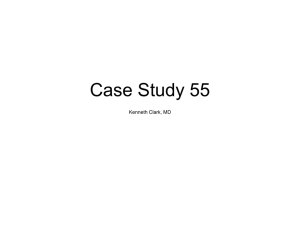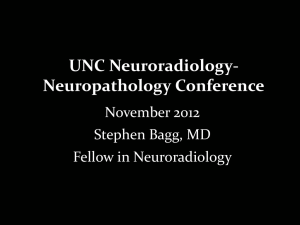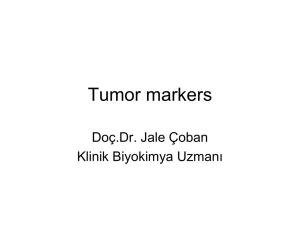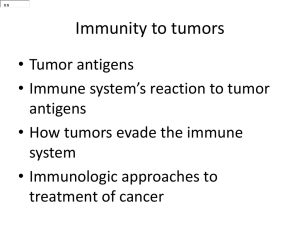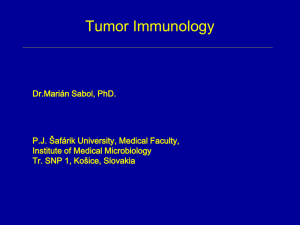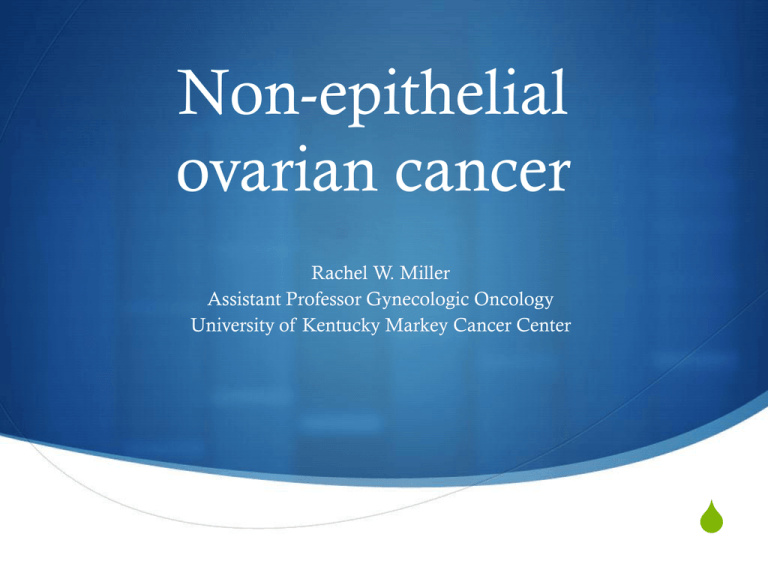
Non-epithelial
ovarian cancer
Rachel W. Miller
Assistant Professor Gynecologic Oncology
University of Kentucky Markey Cancer Center
S
Types of Ovarian Cancer
Epithelial Ovarian Cancer (90%)
1.
•
•
•
•
•
•
Serous/Papillary serous (80%)
Mucinous (10%)
Endometrioid (10%)
Clear Cell
Brenner Tumors
*Borderline Tumors*
Germ Cell Tumors
2.
•
Dysgerminoma
•
Yolk Sac Tumors/Endodermal sinus tumor
Embryonal Carcinoma
•
•
•
Choriocarcinoma
Teratomas
Sex-cord Stromal Tumors
3.
•
Granulosa Cell Tumors
Fibrosarcoma
•
Sertoli-Leydig Tumors
•
Germ Cell Tumors
S 20% of all ovarian tumors
S 2-3% of ovarian malignancies
S Presentation at young age (early 20’s)
S Tumor markers
S hCG
S αFP
S LDH
Evolution of Germ Cell Tumors
Dysgerminoma
Germ cell
Embryonal Carcinoma
Morula
Polyembryoma
Embryo
Yolk sac
Blastula
Teratoma
Endodermal sinus tumor
Choriocarcinoma
Ovarian Germ Cell Tumors
Germ Cell Tumors
S Dysgerminoma
S Choriocarcinoma
S Endodermal sinus
S Embryonal carcinoma
tumor
S Teratoma
S Immature
S Mature
S Struma ovarii
S Carcinoid
S Polyembryoma
S Mixed GCT
S Combo GCT/Stromal
S Gonadoblastoma
S Other
Dysgerminoma
S Lance Armstrong
S Incidence
S 1-2% of ovarian tumors
S 3-5% of ovarian malignancies
S 40% of all GCT
S Peak incidence age 19
S 67% stage IA
S 10-15% bilaterality
S 20% in “normal appearing” opposite ovary
Dysgerminoma
Dysgerminoma
Dysgerminoma
S Presentation
S Solid, lobulated, and can be large
S 15% associated with mature cystic teratoma
S Associated with gonadal dysgenesis and gonadoblastoma
S High growth fraction, lymphatic spread
S Tumor markers
S LDH, placental alkaline phosphatase
S Survival
S Overall =86%
S Stage I =90%
Dysgerminoma
S Fertility-sparing surgery
S 85% of patients are younger than 35 yo
S Consider uterine preservation (IVF)
S Radiosensitive
S Chemotherapy
S Combination, dose-intense regimen
Dysgerminoma
S Large, round, ovoid or
polygonal cells
S Nest and cords of primitive
appearing germ cells
S Lymphatic space invasion
is common
Dysgerminoma
Incidence Survival
Stage IA
70%
Stage IB
10%
Stage II, III
15%
92%
10-year
>90%
5-year
>90%
Stage IV
5%
80%
Endodermal Sinus Tumor
S Presentation
S 20% of all GCT
S Median age 19 yo
S Abdominal pain, large mass
S 10-30 cm common
S Very rapid growth, intra-abdominal and hematological spread
S Tumor marker: AFP, α1 antitrypsin
S Synonyms
S Yolk sac tumor
S Survival
S Overall survival =70%
S Stage I =90%
Endodermal Sinus Tumor
S Solid tumor with
hemorrhage and gelatinous
necrosis on cut surface
S Microscopy
S Hyaline globules
S Reticular Pattern
S Schiller-Duval bodies
S Single blood vessel surrounded
by neoplastic cells
Endodermal Sinus Tumor
Hyaline globules → α1 anti-trypsin
Endodermal Sinus Tumor
Schiller-Duval bodies
Teratomas
S Immature
S Mature
S Specialized
S Struma ovarii
S Carcinoid
Immature Teratoma
S Presentation
S
S
S
S
20% of all GCT
75% in first 2 decades of life
12-15% bilateral
60-70% are Stage I
S Rarely produce tumor markers: αFP and CA-125
S Grade is determined by % immature neural tissue
S Stage IA grade 1 → no adjuvant therapy
S Survival
S
S
Overall =63%
Stage I =75%
Immature Teratoma
Immature Teratoma
Primitive neural elements
Immature Teratoma
Grade
Scully
Norris
0
Well differentiated
All mature; rare mitoses
1
Well differentiated; rare
embryonal tissue
Some immature and
neuroepithelium
2
Moderate embryonal;
atypia and mitoses
Immature neuroepithelium
≤ 3 lpf
3
Large embryonal; atypia Immature neuroepithelium
and mitoses
in ≥ 4 lpf
Significance of Grading
Grade
Number
Tumor Deaths
1
22
4 (18%)
2
24
9 (37%)
3
10
7 (70%)
Mature Teratoma
S 5-25% of all ovarian tumors
S 10-20% bilateral
S Most common ovarian tumor of young women
S Sonography
S Complex, cystic and solid
S Fat/fluid or hair/fluid level, calcifications
S High MI score
S 1-2% with malignant degeneration
S Rokitansky’s protuberance
S Squamous cell cancers possible
Mature Teratoma
Mature Teratoma
Sebaceous glands
Mature Teratoma
Intestinal gland formation
Specialized Teratomas
S Struma ovarii
S 2-3% of all teratomas
S 25-35% have symptoms of hyperthyroidism
S Usually benign, but may undergo malignant transformation
S Carcinoid tumors
S
S
S
S
S
S
Associated with GI or respiratory epithelium
Primary ovarian tumors are rare (N=50)
Often older postmenopausal women
1/3 have carcinoid syndrome from serotonin
Symptoms resolve with excision
5-hydroxyindoleacetic acid in urine
Struma Ovarii
S Follicles contain vividly
eosinophilic, acellular colloid
S Variation in follicular size is
typical
S Can have rich vascularity
Ovarian Carcinoid
S Insular pattern
S Round uniform cells
S Fibroconnective tissue
background
S 80% with neurosecretory
granules
Choriocarcinoma
S Presentation
S Uncommon, aggressive tumor
S Often part of mixed GCT
S Consider met from gestational chorioCA
S Mean age 20 yo, children common
S Half of premenarchal → precocious puberty
S Tumor marker
S hCG
Choriocarcinoma
Cytotrophoblast
S Cytotrophoblast
S Smaller cells
S Smaller nuclei
S Syncitiotrophoblast
S Larger cells
S Eosinophilic
cytoplasm
S Bizarre nuclei
S Hemorrhage
Syncitiotrophoblast
Embryonal Carcinoma
S Presentation
S
S
S
S
S
Mean age < 30 yo
Only 4% of GCT and often part of mixed tumor
60% Stage IA
Poorly differentiated germ cell tumor
Aggressive, intra-abdominal spread and mets common
S Tumor markers: hCG, αFP
S Survival
S Overall =40%
S Stage I =75%
Embryonal Carcinoma
S Large, primitive cells
S Papillary or gland-like
formation, occasional
S Sheets and ribbons
Polyembryona
S Best classified as a mixed tumor
S Never found in pure form
S Fewer than 50 cases
S All under age 40
S Resembles embryonal carcinoma
S Embryo days 13-15
S Treated like other mixed GCT
S Tumor markers: hCG, αFP
Mixed GCT
Embryonal and Choriocarcinoma
Gonadoblastoma
S Combined Germ Cell / Sex Cord Stromal Tumor
S Presentation
S Age 1-38
S Small tumors
S Phenotypic ♀ with virilization
S 90% have Y chromosome
S 22% from streak gonads
S Bilaterality 30-50%
S Check chromosomes for dysgenic gonads
S BSO if Y present
S If testicular feminization syndrome, await puberty before BSO
Gonadoblastoma
S Large germ cells,
clear cytoplasm
S Nests of primordial
germ cells
surrounded by
specialized stromal
cells
S Associated sex cord
stromal cells
Gonadoblastoma
Dysgerminoma
Tumor Markers
Germ Cell Tumors
Histology
AFP
hCG
LDH
PLAP CA-125
Dysgerminoma
-
+
+
+
+
Endodermal
sinus tumor
+
-
+
-
+
Immature
teratoma
Embryonal CA
+
-
-
-
+
+
+
-
+
-
ChorioCA
-
+
-
+
-
Germ Cell Tumors
Treatment
S Surgery
S Importance of staging in early disease
S Fertility-sparing surgery often required
S Can preserve uterus for future IVF, even if BSO
S Debulking improves outcome
Chemotherapy
Germ Cell Tumors
S BEP
S Bleomycin 20 U/m2 weekly x 9
S Etoposide 100 mg/m2 days 1-5 q 3 weeks x 3
S Cisplatin 20 mg/m2 days 1-5 q 3 weeks x 3
S VAC
S Vincristine 105 mg/m2 weekly x 12
S Act D 0.5 mg days 1-5 q 4 weeks
S Cytoxan 5-7 mg/kg days 1-5 q 4 weeks
S VBP
S Vinblastine 12 mg/m2 q 3 weeks x 4
S Bleomycin 20 U/m2 weeks x 7, 8 on week 10
S Cisplatin 20 mg/m2 days 1-5 q 3 weeks x 3
Sex-cord Stromal Tumors
S Fibroma
S Granulosa cell tumors
S Inhibin, CA-125
S Sertoli-Leydig tumors
S CA-125, αFP, sTest
S Steroid cell tumors
S sTest (50-75% virilized)
S Gynandroblastoma
S ♀ and ♂ components
Fibroma
Granulosa Cell Tumor
S Presentation
S
S
S
S
S
S
S
Adult (95%) and juvenile types
Solid and/or cystic- variable
Estrogen, occasional androgen
80% palpable on examination
Hemoperitoneum in 15%
80-90% Stage I
Low grade, late relapse
S Estrogen excess and the endometrium
S 25% proliferative
S 55% hyperplastic
S 13% adenocarcinoma
Granulosa Cell Tumor
Treatment
S Juvenile
S High cure rate
S Adult
S Resection
S Chemotherapy
S
BEP
S
Carboplatin and Taxol
S
GnRH analogs
Granulosa Cell Tumor
Granulosa Cell Tumor
Granulosa Cell Tumor
Granulosa Cell Tumor
Call-Exner bodies
Sertoli-Leydig Tumors
S Benign
S Sertoli cell tumors→ no hormones
S Leydig tumors→ testosterone
S Potentially Malignant
S Sertoli-Leydig tumors
S Arrhenoblastoma, androblastoma
S Grade 3
S 44% five-year survival
Grade % Cancer
1
0
2
10
3
60
Sertoli-Leydig Tumor
Well-differentiated tubules
Treatment Summary
Germ Cell and Stromal Tumors
of the Ovary
S
Dysgerminoma
USO staging if
possible
BEP x 3 cycles if
stage II-IV
Endodermal
sinus tumor
Embryonal
carcinoma
Malignant
teratoma
Granulosa cell
tumor
Debulk but
preserve fertility
BEP x 3-4 cycles
As above
BEP x 3-4 cycles
As above
BEP or VAC
x 3-4 cycles
USO if young
o/w TAH/BSO
Sertoli-leydig
cell
As above
BEP x 3-4 cycles
GnRH agonists for
advanced ds.
BEP or VAC
x 3-4 cycles
Summary
1.
Common in young women
2.
Tumor markers
3.
Treatment
•
•
•
Fertility-sparing surgery
Chemosensitive→ BEP for 3-6 cycles
Radiosensitive
No adjuvant chemo for:
4.
•
•
Stage I pure dysgerminoma
Stage IA grade 1 immature teratoma


